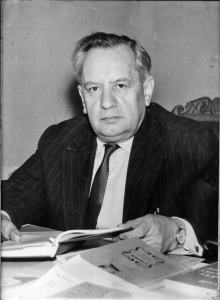1975 d. T. Popoviciu, Analiză numerică (Romanian) [Numerical analysis] Noţiuni introductive de calcul aproximativ. [Introductory notions of approximate calculation] With a French summary and table of contents. Seria: Teoria Calculului, Analiză Numerică şi Informatica, No. 1. [Series: Computing Theory, Numerical Analysis and Information Theory, No. 1] Editura Academiei Republicii Socialiste România, Bucharest, 1975. 234 pp. [MR0391466, Zbl 0312.65003].
1974 b. T. Popoviciu, Curs de analiză matematică. Partea a III-a. Continuitate, Universitatea Babeş-Bolyai Cluj, Facultatea de matematică-mecanică, 1974, 182 pp. (litografiat) (in Romanian).
1972 f. T. Popoviciu, Curs de analiză matematică. Partea a II-a, Funcţii. Limite, 1972, Universitatea Babeş-Bolyai, Facultatea de Matematică-Mecanică, 312 pp. (litografiat) (in Romanian).
1970 a. T. Popoviciu, Curs de analiză matematică. Partea I. Noţiuni introductive. Numere. Mulţimi, 1970, Universitatea Babeş-Bolyai, 294 pp. (litografiat) (in Romanian).
1967d. T. Popoviciu, Analiză numerică, vol. 1, Noţiuni introductive de calcul aproximativ, Academia R.S.R., Filiala Cluj, Institutul de Calcul, 248 pp. (litografiat) (in Romanian).
1966b. T. Popoviciu, Calcul practic. Ciclu de conferinţe ţinute la AGIR în anul 1949 de T. Popoviciu, Academia R.P.R., Filiala Cluj, Institutul de Calcul, Cluj, 1966, no. 16, 61 pp. (litografiat) (in Romanian).
1948d. T. Popoviciu, Curs de algebră superioară: numere reale şi complexe, noţiuni de teoria numerelor, vol. I-II, 1948, XX pp.
1947a. T. Popoviciu, Elemente de analiză matematică, 1947 [curs universitar], XX pp.
1944a. T. Popoviciu, Les fonctions convexes, Actualités scientifiques et industrielles, fasc. 992, 75 pp., Hermann & Cie (Eds.), Paris, 1944 (in French) [MR0018705, Zbl 0060.14911]
1941g. T. Popoviciu, Curs de calcul diferenţial şi integral, partea I., Bucureşti, 1940-1941, XX pp. (litografiat) (in Romanian).
1938j. T. Popoviciu, Curs de matematici generale – ţinut în anul şcolar 1937-38 de conf. dr. Tib. Popoviciu, împreună cu 202 probleme propuse la seminar şi 98 figuri în text, 1938; acest curs a fost scris [dactilografiat] şi figurile executate de Scurei P. Emilian, student chimist.
1937a. T. Popoviciu, Despre cea mai bună aproximaţie a funcţiilor continue prin polinoame, Monografii matematice, fasc. III, Cluj, Institutul de Arte Grafice “Ardealul”, (66 pp.) (in Romanian) [JFM 63.0959.03].
1937f. Th. Angheluţă, Gh. Călugăreanu, P. Montel, T. Popoviciu, Exerciţii şi probleme de analiză, teoria funcţiilor şi mecanică raţională, 1937, x pp., Editura Universităţii din Cluj (in Romanian).


